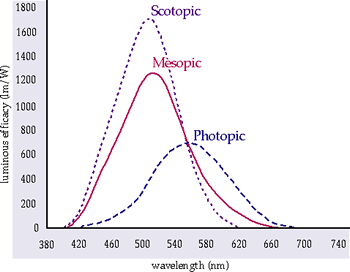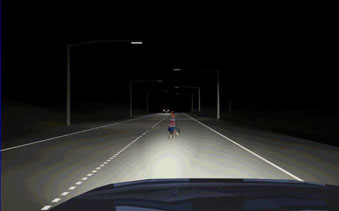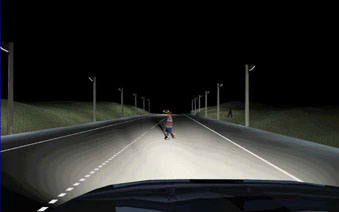The Long and Lighted Road: Lighting and Driving
Roadway Lighting
The Roadway as a System
What will be the future of roadway lighting? Certainly, it's reasonable to suppose that we will have roadway lighting with us for as long as we will have roads. Roadway lighting consumes 14 billion kWh annually in the United States. Not only does street lighting provide for visibility by illuminating objects and potential hazards in and along the roadway, it can also serve as a tool in economic development. Many historic downtowns are using decorative street lighting with historic character, for example, as part of overall renovations designed to bring both drivers and pedestrians, and their wallets, into these areas to patronize shops, restaurants and theaters.

|
| At low (mesopic and scotopic) light levels, peripheral vision is more sensitive to shorter-wavelength ("bluer") light. Shown above are the photopic and scotopic luminous efficacy functions, and a mesopic function for one light level. |
But visibility and safety are still among the primary reasons to have street and roadway lighting. Most roadway lighting in the United States uses high intensity discharge (HID) light sources: high pressure sodium (HPS) and metal halide (MH). HPS lamps are known for their high lumen ratings and their yellowish tint; MH lamps produce fewer lumens than HPS and have a whiter appearance. But lumen ratings don't tell the user everything about potential visibility. Recent research has shown that at low (called "mesopic") light levels, like those typically specified on roadways at night, the spectral (color) sensitivity of our peripheral vision shifts toward shorter wavelengths ("bluer" light) and because of this shift, response times to objects in the periphery can be shorter under MH lamps than under HPS lamps, despite the lower lumen rating of MH. For non-peripheral tasks, like reading roadway signs, this advantage is not present.
It is worth noting too that in the future, manufacturers might optimize the color of HID and other light sources, such as fluorescent lamps, to more efficiently match the spectral response of the peripheral visual system at low light levels.
Armed with the results of this research, Mark Rea, who is the director of the Lighting Research Center and author of many of the aforementioned visibility studies, recently proposed a sketch for a new approach to roadway lighting at a conference of lighting engineers in York, England. The typical roadway lighting approach is to uniformly light the roadway surface, helping to make objects on it visible to drivers, as shown in the first rendering below. Rea suggests a systems approach, allowing vehicular headlighting to carry the burden of lighting objects on the road, and essentially turning roadway luminaires around so that they illuminate areas along the edge of the roadway, as shown in the second rendering below. In this way, objects and potential hazards not yet on the road stand a better chance of being detected, and roadway luminaires could use light sources designed to take better advantage of the spectral effects described above. Of course, before actually advocating such a systems approach to roadway lighting, Rea states, these principles would have to be validated in actual field installations.

|
| Conventional roadway lighting illuminates the surface of the roadway. |
 |
| One proposal for roadway lighting involves acknowledging the work done by automotive headlamps in illuminating the surface of the roadway, allowing luminaires to illuminate potential hazards near the roadway. |
As roadway lighting becomes more sophisticated, so does our understanding of its impacts beyond simply providing visibility. Light pollution and light trespass are being recognized more and more as real effects of excessive or poorly designed exterior lighting. To combat light pollution and light trespass, the following measures have been advocated:
- use of cutoff luminaires so that bare lamps are not visible in roadway lighting fixtures, except from directly beneath them
- designing lighting installations that provide the minimum amount of light needed for safety
- in certain cases, such as in the vicinity of astronomical observatories, use of narrow-spectrum lamps, like low pressure sodium, which can be easily filtered by astronomers
We will see a growing awareness and optimization of these issues as roadway and street lighting continues to evolve as a system. An increasing importance is being placed on roadways and highways as engines of economic growth, and the incorporation of lighting and visibility issues into such programs as intelligent transportation systems (ITS) will require understanding not only about lighting technologies but the transportation-related tasks and processes that lighting supports.
Introduction | Interior | Headlights | Vehicle Signals | Roadway | Traffic Signals | Links | Credits


